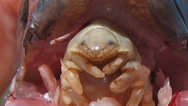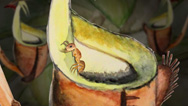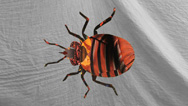Poop-Eating Sloth Moths
- By Anna Rothschild and Jacqueline Mason
- Posted 01.30.14
- NOVA
There's no denying it—sloths are simply one of the most adorable animals on the planet. But they're more than just lovable bundles of slow-moving fur. In fact, sneaking around in that fur are poop-eating moths, mites, and many other unsavory hangers-on.
Transcript
Poop-Eating Sloth Moths
January 30, 2014
NARRATOR: Sloths: you probably know them as the most adorable creatures on the planet. But you might want to think twice before snuggling with one, because their fur is actually home to whole communities of organisms—some of them not so cute.
To begin with, sloths are often covered in green symbiotic algae, which keeps them camouflaged in the trees where they live. But that’s not all—their fur is also home to sloth moths.
Over 120 sloth moths have been found on a single sloth at a time. There are a few different species, but most of them have pretty similar lifestyles. They live in the sloth’s fur and feed on the algae, along with sloth skin secretions. They even mate on the sloth. On three-toed sloths, when it’s time for the females to lay their fertilized eggs, they wait until the sloth takes a bathroom break. This doesn’t happen very often—three-toed sloths only climb down from their tree about once a week to poop—when they do, the female moths lay their eggs in the poop.
Soon the eggs hatch, and coprophagous, or poop-eating moth larvae emerge. And, when the larvae mature, they fly up into the trees looking for another sloth to colonize.
This is all very well for the moths, but this bizarre bathroom behavior has puzzled scientists for years—being close to the ground makes sloths vulnerable to predators, so why bother leaving the canopy for a trip to the toilet?
Recently, scientists suggested that the sloths are actually getting a meal out of this deal. It turns out that the moths may help cultivate the fur algae by providing it nutrients. And the algae may do more than just camouflage—the sloths may actually eat it, as well. It’s a tiny ecosystem, all in the fur of a sloth.
But, algae and poop-eating sloth moths are just the beginning. Sloths also harbor scarab beetles in their fur—as many 980 of them on a single sloth—along with mites that live in their skin and in their butts. And on top of that, they have been known to carry a variety of human diseases, including leishmaniasis, a single-celled parasite that causes major skin lesions.
Of course, this menagerie living in their fur makes sloths an important part of the Central American ecosystem. So while we should do our parts to preserve sloths and their habitats, you might want to think twice before hugging one. Unless you’d like to snuggle with a few moths as well.
Credits
PRODUCTION CREDITS
- Written by
- Anna Rothschild and Jacqueline Mason
- Illustrated by
- Jacqueline Mason
- Edited by
- Anna Rothschild
- Narrated by
- Anna Rothschild
- Original Footage
- © WGBH Educational Foundation 2013
MEDIA CREDITS
- Olde Timey
- Incompetech/Kevin MacLeod (CC BY 3.0)
- Baby sloth, rescued from captivity and to be returned to the wild
- Flickr/NikonFanboy (CC BY 2.0)
- Bradypus
- Wikimedia Common/StefanLaube (Public Domain)
- MC Drei-Finger-Faultier
- Wikimedia Commons/ChristianMehlfí¼hrer (CC BY 2.5)
- Two toed Sloth 1 (4871864739)
- Wikimedia Commons/Tony Kisgett (CC BY 2.0)
- Baby Sloth, Punta Uva, Costa Rica
- Picasa Web Albums/Andrea MacDougall (CC BY-NC 3.0)
- Sloth in Arms
- Flickr/Smitten with Kittens (CC BY 2.0)
- Sloth Poking Head Out of Bin
- Flickr/qmnonic (CC BY 2.0)
- Rujido dos
- Freesound/pepingrilling (CC0 1.0)
- Candy wrapper bite A
- Freesound/volivieri (CC BY 3.0)
- Fart5
- Freesound/zippi1 (CC BY-NC 3.0)
- Fart
- Freesound/smokenweewALT (CC0 1.0)
IMAGE
- (main image: Sloth Poking Head Out of Bin)
- Flickr/qmnonic (CC BY 2.0)
Related Links
-

The Tongue-Eating Parasite
Gross science: This parasite crawls into a fish's mouth and replaces its tongue. Enough said.
-

Carnivorous Plants, Killer Ants
Ant eats plant's parasites. Plant eats ant's poop. It's the circle of life.
-

Bed Bug Sex
Gross Science: How bed bugs reproduce is the stuff of nightmares.
-

Inside Animal Minds
In this series, go inside the brains of three smart animals—dogs, birds, and dolphins.

